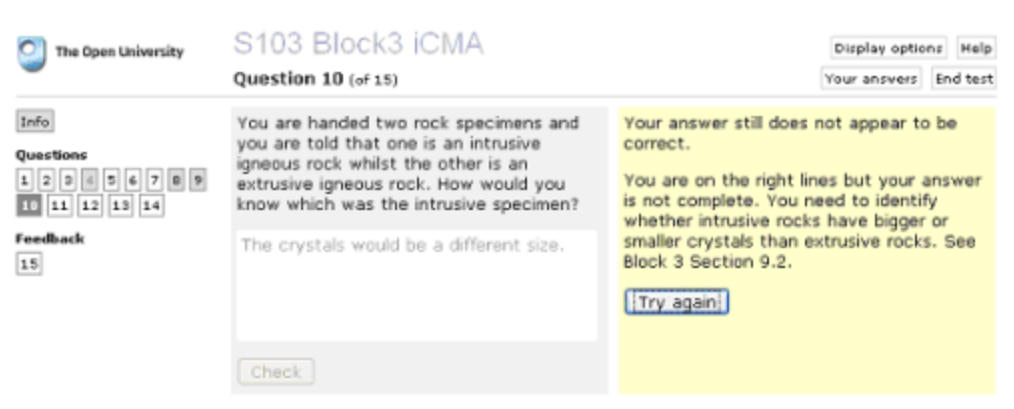La influencia de OpenMark en la Open University
Nota: Pendiente de Traducir. ¡Anímese a traducir esta página!. ( y otras páginas pendientes)
OpenMark is an Open University computer-assisted assessment (CAA) system that has its foundations in computer-assisted learning. It had existed in various guises for almost a decade prior to the arrival of Moodle and it had been designed by OU staff for use in the OU’s open learning model. It differs from traditional CAA systems in:
- The emphasis we place on feedback. All Open University students are distance learners and within the university we emphasise the importance of giving feedback on written assessments. The design of OpenMark assumes that feedback, perhaps at multiple levels, will be included.
- Allowing multiple attempts. OpenMark is an interactive system, and consequently we can ask students to act on feedback that we give 'there and then', while the problem is still in their mind. If their first answer is incorrect, they can have an immediate second, or third, attempt.
- The breadth of interactions supported. We aim to use the full capabilities of modern multimedia computers to create engaging assessments. We do not hide the computer. Instead we harness the computing power available to us to enrich the learning process.
- The design for anywhere, anytime use. OpenMark assessments are designed to enable students to complete them in their own time in a manner that fits with normal life. They can be interrupted at any point and resumed later from the same location or from elsewhere on the internet.
5.1 The OpenMark system in 2006 using Intelligent Assessment Technology’s software to perform the response matching. Since 2010 responses of this type are handled by OpenMark's internal response matching algorithm (Butcher & Jordan, 2010).
Our experiences in planning, developing, using and evaluating OpenMark (Whitelock, 1998; Jordan et al, 2003) over such a long period provided us with a clear vision of what we might achieve during our stewardship of the Moodle Quiz. In terms of student interactions we wanted Moodle to be more like OpenMark and we asked ourselves how we might achieve this.
It took three years for Tim Hunt to formulate his design for the Moodle Question engine so that he could include our local, OpenMark influenced, changes to OU Moodle within Moodle core. In 2009 we gave Tim our backing to go ahead with the redevelopment and he spent much of 2010 working on this major re-engineering exercise. His new engine has been powering the questions at the OU since December 2010 and has been available to others since the release of Moodle 2.1.
References
Butcher, P. G. (2006-2014) OpenMark Examples
Butcher, P. G. and Jordan, S. E. (2010) A Comparison Of Human And Computer Marking Of Short Free-Text Student Responses, Computers & Education. Available online: DOI information: http://dx.doi.org/ 10.1016/ j.compedu.2010.02.012
Jordan S, Butcher P, & Ross S (2003) Mathematics Assessment at a Distance, Maths CAA Series: July 2003 http://www.mathstore.ac.uk/ articles/ maths-caa-series/ july2003/ index.shtml
Whitelock D (1998) S103 Students’ response to the Block 2 CD-ROM materials: Findings of a postal survey. PLUM report 109 (Internal report), Institute of Educational technology, The Open University, Milton Keynes.
Traducido de http://www.open.edu/openlearnworks/mod/oucontent/view.php?id=51788§ion=5
